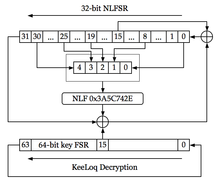
The Advanced Encryption Standard (AES), also known by its original name Rijndael, is a specification for the encryption of electronic data established by the U.S. National Institute of Standards and Technology (NIST) in 2001.
In cryptography, a block cipher is a deterministic algorithm that operates on fixed-length groups of bits, called blocks. Block ciphers are the elementary building blocks of many cryptographic protocols. They are ubiquitous in the storage and exchange of data, where such data is secured and authenticated via encryption.

In cryptography, a cipher is an algorithm for performing encryption or decryption—a series of well-defined steps that can be followed as a procedure. An alternative, less common term is encipherment. To encipher or encode is to convert information into cipher or code. In common parlance, "cipher" is synonymous with "code", as they are both a set of steps that encrypt a message; however, the concepts are distinct in cryptography, especially classical cryptography.

Cryptanalysis refers to the process of analyzing information systems in order to understand hidden aspects of the systems. Cryptanalysis is used to breach cryptographic security systems and gain access to the contents of encrypted messages, even if the cryptographic key is unknown.

The Data Encryption Standard is a symmetric-key algorithm for the encryption of digital data. Although its short key length of 56 bits makes it too insecure for modern applications, it has been highly influential in the advancement of cryptography.

In cryptography, encryption is the process of encoding information. This process converts the original representation of the information, known as plaintext, into an alternative form known as ciphertext. Ideally, only authorized parties can decipher a ciphertext back to plaintext and access the original information. Encryption does not itself prevent interference but denies the intelligible content to a would-be interceptor.

Symmetric-key algorithms are algorithms for cryptography that use the same cryptographic keys for both the encryption of plaintext and the decryption of ciphertext. The keys may be identical, or there may be a simple transformation to go between the two keys. The keys, in practice, represent a shared secret between two or more parties that can be used to maintain a private information link. The requirement that both parties have access to the secret key is one of the main drawbacks of symmetric-key encryption, in comparison to public-key encryption. However, symmetric-key encryption algorithms are usually better for bulk encryption. With exception of the one-time pad they have a smaller key size, which means less storage space and faster transmission. Due to this, asymmetric-key encryption is often used to exchange the secret key for symmetric-key encryption.
In cryptography, linear cryptanalysis is a general form of cryptanalysis based on finding affine approximations to the action of a cipher. Attacks have been developed for block ciphers and stream ciphers. Linear cryptanalysis is one of the two most widely used attacks on block ciphers; the other being differential cryptanalysis.

In cryptography, a block cipher mode of operation is an algorithm that uses a block cipher to provide information security such as confidentiality or authenticity. A block cipher by itself is only suitable for the secure cryptographic transformation of one fixed-length group of bits called a block. A mode of operation describes how to repeatedly apply a cipher's single-block operation to securely transform amounts of data larger than a block.

In cryptography, ciphertext or cyphertext is the result of encryption performed on plaintext using an algorithm, called a cipher. Ciphertext is also known as encrypted or encoded information because it contains a form of the original plaintext that is unreadable by a human or computer without the proper cipher to decrypt it. This process prevents the loss of sensitive information via hacking. Decryption, the inverse of encryption, is the process of turning ciphertext into readable plaintext. Ciphertext is not to be confused with codetext because the latter is a result of a code, not a cipher.
The Common Scrambling Algorithm (CSA) is the encryption algorithm used in the DVB digital television broadcasting for encrypting video streams.

In cryptography, DES-X is a variant on the DES symmetric-key block cipher intended to increase the complexity of a brute-force attack. The technique used to increase the complexity is called key whitening.
Probabilistic encryption is the use of randomness in an encryption algorithm, so that when encrypting the same message several times it will, in general, yield different ciphertexts. The term "probabilistic encryption" is typically used in reference to public key encryption algorithms; however various symmetric key encryption algorithms achieve a similar property, and stream ciphers such as Freestyle which are inherently random. To be semantically secure, that is, to hide even partial information about the plaintext, an encryption algorithm must be probabilistic.
In cryptography, FROG is a block cipher authored by Georgoudis, Leroux and Chaves. The algorithm can work with any block size between 8 and 128 bytes, and supports key sizes between 5 and 125 bytes. The algorithm consists of 8 rounds and has a very complicated key schedule.
In cryptanalysis, attack models or attack types are a classification of cryptographic attacks specifying the kind of access a cryptanalyst has to a system under attack when attempting to "break" an encrypted message generated by the system. The greater the access the cryptanalyst has to the system, the more useful information they can get to utilize for breaking the cypher.
A rolling code is used in keyless entry systems to prevent a simple form of replay attack, where an eavesdropper records the transmission and replays it at a later time to cause the receiver to 'unlock'. Such systems are typical in garage door openers and keyless car entry systems.

Cryptography, or cryptology, is the practice and study of techniques for secure communication in the presence of adversarial behavior. More generally, cryptography is about constructing and analyzing protocols that prevent third parties or the public from reading private messages. Modern cryptography exists at the intersection of the disciplines of mathematics, computer science, information security, electrical engineering, digital signal processing, physics, and others. Core concepts related to information security are also central to cryptography. Practical applications of cryptography include electronic commerce, chip-based payment cards, digital currencies, computer passwords, and military communications.
The following outline is provided as an overview of and topical guide to cryptography:

Speck is a family of lightweight block ciphers publicly released by the National Security Agency (NSA) in June 2013. Speck has been optimized for performance in software implementations, while its sister algorithm, Simon, has been optimized for hardware implementations. Speck is an add–rotate–xor (ARX) cipher.

Simon is a family of lightweight block ciphers publicly released by the National Security Agency (NSA) in June 2013. Simon has been optimized for performance in hardware implementations, while its sister algorithm, Speck, has been optimized for software implementations.














